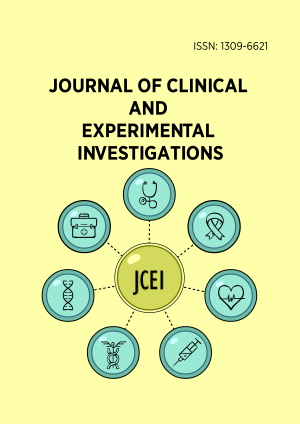Volume 2, Issue 2, June 2011
Research Article
Oral zinc sulphate in treatment of patients with thallium poisoning: A clinical therapeutic trial
J Clin Exp Invest, Volume 2, Issue 2, June 2011, 133-137
https://doi.org/10.5799/ahinjs.01.2011.02.0226Research Article
Effectiveness of sevoflurane or propofol combined with remifentanil for intubation without muscle relaxants
J Clin Exp Invest, Volume 2, Issue 2, June 2011, 138-143
https://doi.org/10.5799/ahinjs.01.2011.02.0227Research Article
The effect of extremely low frequency magnetic field on heart tissue iron density
J Clin Exp Invest, Volume 2, Issue 2, June 2011, 144-148
https://doi.org/10.5799/ahinjs.01.2011.02.0228Research Article
Does obturator nerve block always occur in 3-1 block?
J Clin Exp Invest, Volume 2, Issue 2, June 2011, 149-151
https://doi.org/10.5799/ahinjs.01.2011.02.0229Research Article
The comparison of free androgen index and serum free testosterone levels in women with hirsutism or polycystic ovary syndrome
J Clin Exp Invest, Volume 2, Issue 2, June 2011, 152-156
https://doi.org/10.5799/ahinjs.01.2011.02.0230Research Article
The use of child safety seats: A survey on levels of knowledge and attitudes of university employees
J Clin Exp Invest, Volume 2, Issue 2, June 2011, 157-160
https://doi.org/10.5799/ahinjs.01.2011.02.0231Research Article
Association of a single nucleotide polymorphism in the SUR1 gene with type 2 diabetes and obesity in Turkish patients
J Clin Exp Invest, Volume 2, Issue 2, June 2011, 161-167
https://doi.org/10.5799/ahinjs.01.2011.02.0232Research Article
Treatment of tibial diaphysis fractures with reamed and locked intramedullary nailing
J Clin Exp Invest, Volume 2, Issue 2, June 2011, 168-174
https://doi.org/10.5799/ahinjs.01.2011.02.0233Research Article
Effects of vitamin C supplementation on iron and iron binding capacity in sports players after training
J Clin Exp Invest, Volume 2, Issue 2, June 2011, 175-180
https://doi.org/10.5799/ahinjs.01.2011.02.0234Research Article
Evaluation of the warm-up habits and knowledge levels in amateur athletes
J Clin Exp Invest, Volume 2, Issue 2, June 2011, 181-186
https://doi.org/10.5799/ahinjs.01.2011.02.0235Research Article
The relationship between level of anti-CCP, clinical activity and quality of life in patients with psoriatic arthritis
J Clin Exp Invest, Volume 2, Issue 2, June 2011, 187-191
https://doi.org/10.5799/ahinjs.01.2011.02.0236Research Article
The frequency and disribution of cancer cases in Hatay District in 2008
J Clin Exp Invest, Volume 2, Issue 2, June 2011, 192-195
https://doi.org/10.5799/ahinjs.01.2011.02.0237Research Article
Thyroid dysfunction during pregnancy and evaluation of its results
J Clin Exp Invest, Volume 2, Issue 2, June 2011, 196-201
https://doi.org/10.5799/ahinjs.01.2011.02.0238Research Article
Serum oxidative stress status in CagA positive Helicobacter pylori infection
J Clin Exp Invest, Volume 2, Issue 2, June 2011, 202-206
https://doi.org/10.5799/ahinjs.01.2011.02.0239Research Article
Evaluation of patients with upper gastrointestinal bleeding in chronic renal failure
J Clin Exp Invest, Volume 2, Issue 2, June 2011, 207-213
https://doi.org/10.5799/ahinjs.01.2011.02.0240Case Report
The efficiency of valproic acid in a child with trichotillomania
J Clin Exp Invest, Volume 2, Issue 2, June 2011, 214-215
https://doi.org/10.5799/ahinjs.01.2011.02.0241Case Report
Mad-Honey intoxication leading to severe arrhythmia
J Clin Exp Invest, Volume 2, Issue 2, June 2011, 216-218
https://doi.org/10.5799/ahinjs.01.2011.02.0242Case Report
Rupture of a rudimentary horn at 16 weeks of gestation
J Clin Exp Invest, Volume 2, Issue 2, June 2011, 219-221
https://doi.org/10.5799/ahinjs.01.2011.02.0243Case Report
Three cases with papillon-lefevre syndrome
J Clin Exp Invest, Volume 2, Issue 2, June 2011, 222-224
https://doi.org/10.5799/ahinjs.01.2011.02.0244Case Report
Anomali of left main coronary artery arising from the right sinus of valsalva
J Clin Exp Invest, Volume 2, Issue 2, June 2011, 225-227
https://doi.org/10.5799/ahinjs.01.2011.02.0245Case Report
A very rare case with neglected hip dislocation coexisted with posterior acetabular lip fracture
J Clin Exp Invest, Volume 2, Issue 2, June 2011, 228-231
https://doi.org/10.5799/ahinjs.01.2011.02.0246Case Report
A case with catecholaminergic polymorphic ventricular tachycardia
J Clin Exp Invest, Volume 2, Issue 2, June 2011, 232-234
https://doi.org/10.5799/ahinjs.01.2011.02.0247Case Report
Cytomegalovirus pneumonia as cause of persistently wheezing in an infant with cystic fibrosis
J Clin Exp Invest, Volume 2, Issue 2, June 2011, 235-237
https://doi.org/10.5799/ahinjs.01.2011.02.0248Review
Parathyroid scintigraphy in preoperative detection of parathyroid adenomas and use of gama probe in minimal invasive surgery
J Clin Exp Invest, Volume 2, Issue 2, June 2011, 238-243
https://doi.org/10.5799/ahinjs.01.2011.02.0249
